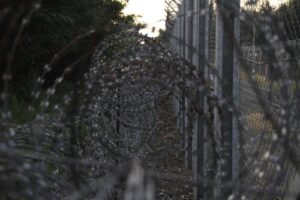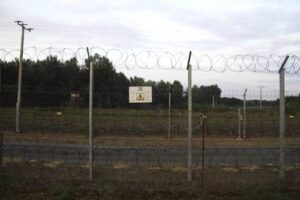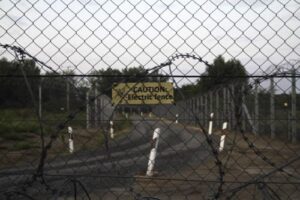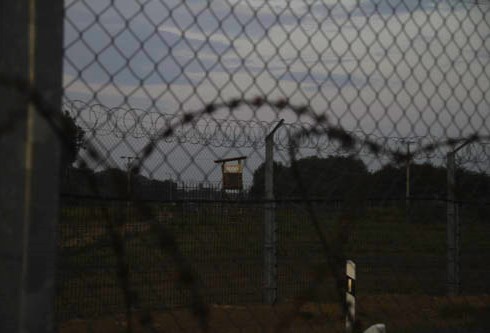Text and photos by Matthias Canapini* – Unimondo**
This third episode is set in Belgrade (read the first and second ones)
Deportation of 120 migrants by 300 uniformed men, including special forces. Except for six Afghans, they are all loaded onto Niš Ekspres buses, which set off with sirens blaring to who knows where. Inevitably, the scene attracts the attention of some passers-by, including Giorgis, the night porter at the Bristol Hotel: ‘We’ll never know where they’re being taken. This morning, at about 4 am, I saw policemen and soldiers bursting into the disused hotel next door and throwing themselves on the boys. You know, in this story of Belgrade on the water, profit does not look anyone in the face: it displaces and rebuilds. Last winter, the barracks were demolished, not because of the inhumane conditions in which the migrants lived, as they had complained on TV, but to grab land, and build a shopping centre, cycle paths, and villas for the rich. The citizens protested (also because the buildings under construction would completely change the skyline of Old Belgrade) but to no avail. They are too powerful… while the migrants, well, none of them want to stay here, they all flee to the north: Germany, Sweden, rarely Italy”. Compared to 2015, nothing in the city shows any trace of the ongoing exoduses. The Balkan route has changed even more. Afghan Park (so-called because of the large number of Afghans present there every day) does not welcome a single soul. The whole affluent neighbourhood that Giorgis mentioned is still far from being built. A few buildings under construction, complete with cranes, concrete mixers and scaffolding, have replaced the huts used by around a thousand migrants last winter. As I wait for a minibus to take me to the transit centre for asylum seekers in Bogovadja, I scan the avenue where the morning’s eviction and deportation took place. The hunt must have resulted in a hasty escape, an animalistic paraphernalia that left inanimate bodies in the field: toothbrushes, blankets, broken glass. “I have worked with migrants before, but at that time (mid-1990s) they were internally displaced people fleeing the war in Bosnia,” says Milena, a psychologist at Caritas Valjevo, as she flips through stapled medical files. “Now I see that the most common disorder in both categories is depression. Some of them have been living here for a year or two; they have no prospects or emotional outbursts, and sometimes the step towards serious psychiatric disorders is just around the corner. Europe is an obsessive dream that wears you down inside and makes you irritable. Feelings of disorientation, loss of sense of self, impulsive behaviour, emotional instability and a tendency to depression, caused by long stays in a very isolated place (they have to walk almost two hours to get to the nearest centre) and the uncertain outcome of their migration experience. What hurts me most is to see the order of this place, which looks like a normal colony to us, but for them, it is the edge of the world. Outside there is the nation, the mistrust, the unobtained documents”.

Arman, a friendly and energetic teenager, has recently had 2+2=5 tattooed on his wrist, perhaps proving that nothing is written in life; a lonely minor who ran away from Iran at the age of 14 perhaps knows this better than most. Before pricking up my ears, I smile, noticing a leaflet translated into English: Welcome to Serbia. If you are under 18, you are a child! Accompanied by a map showing centres for asylum seekers and/or unaccompanied minors: Tutin, Sjenica, Banja Koviljaca. “I would like to reach Italy because I have several friends there… in Milan, Trieste, Bologna. I speak about ten languages, between dialects and European idioms. I used to play football for a club in Tehran and we often organised trips abroad. Unfortunately, I had problems at home: my father was a violent man and more than once he involved me in his illegal activities. My coach helped me cross the Turkish border. From Bulgaria, I was on my own. I spent two months in prison and one on the street. I tried to cross the Balkans from all sides; for a while, I dealt drugs in Romania, I was 16 years old and I got by. I also tried to go to night school but to no avail. Now I am here, without money, alone with my seventeen years. I love two things in my life: God and my mother. I try to be a good person despite all the trouble I’ve been in.” With an arrogant grin on his face, Arman asks me if fleeing from Islamic law, which legitimises flogging for trivial offences, is not a good reason to leave. Do you have to starve or run from bombs to justify fleeing?
Without knowing it, in a few minutes, it will be Elham, a former English teacher in Tabriz, who will be answering some of the ‘child’s’ questions. She is walking in the camp’s large garden, stroking the bark of the lime trees. “On 1 February 1979, just over forty years ago, the Shiite cleric Ruhollah Khomeini arrived at Tehran airport after many years in exile abroad. He was met by thousands of people who had spent the previous weeks supporting the revolution against Shah Mohammad Reza Pahlavi, who had ruled Iran authoritatively since 1941. Khomeini was the most charismatic of the clerics, popular thanks to the propaganda tapes illegally sent from France, which had won him a large following. Khomeini quickly became the leader of the Iranian revolution: he sidelined all other political forces that had conspired against the Shah, including communists and nationalists, and imposed an unprecedented system of government. Khomeini transformed Iran into an Islamic republic and radically altered its international alliances, with enormous consequences for the whole of the Middle East. I was ten years old in 1979. Many things had changed in Iran, but not the system of power imposed by the first revolutionary clerics, with very controversial and questionable results. From the moment the iron fist of the Islamic revolution fell on Iran, women stopped wearing Western clothes and make-up. We lost the freedom to express ourselves, and those who disagreed were thrown into prison at the risk of dying there. My father was an army officer and always spoke well of the pre-dictatorship period. Maybe I was living in a bubble, I don’t know, but the economy was good and the people were educated. Now most people live below the poverty line, which is why my husband and I decided to flee with our two children.
At the border between Iran and Turkey, our luggage disappeared and the police acted as if nothing had happened. Somehow we got on a plane from Istanbul to Belgrade, and now we are waiting for refugee status. Today we have been here for 100 days. At first, I was happy, but lately, I prefer to stay locked in my room. It is humiliating and disgusting to live like this. As soon as we get humanitarian protection, I will contact the UNHCR to apply for a job. It would take so little: open the borders, facilitate the procedures… We are human beings and we have the right to migrate where we want.” Many fear that once the ‘great migration’ is over, the Bogovadja camp will become a rehabilitation centre for mentally ill migrants. There are many examples of this, and you only have to shake hands with a quarter of the one hundred and twenty residents to find out. Like Abib, who used to work as a fireman in Kashmir, India’s northernmost state, mostly in the Himalayas. To expose the culprits behind the collapse of a government building, he was forced to flee. Unable to endure the confinement of the barbed-wire encircled camps, he has been loitering in Bogovadja for several weeks, dazed and spiritually corroded.

The ‘Social Café’, run by Ipsia (Istituto Pace Sviluppo Innovazione Acli), is a warm and welcoming place where minors can overcome their traumas, surf the Internet, play and learn thanks to the school kits provided. Cautious and sociable, the minors move around in groups: they seem to be made of different stuff. They show genuine respect for their elders and for a social hierarchy that is often scorned in the West. After years I meet Silvia Maraone again, an expert on the Balkans and migration, currently coordinator of projects for the protection of refugees and asylum seekers along the Balkan route (particularly in Serbia and Bosnia-Herzegovina) on behalf of Ipsia and Caritas Italiana. It is a good opportunity to retrace steps and chat without filters. “I met Ipsia in 1993 through the ‘Un Sorriso Per la Bosnia’ project. At that time I was working with refugees in Slovenia. Bosniaks, Muslims, Croats, a few Serbs. Same situation as today, only the countries of origin have changed. Sometimes I wonder what kind of refugee I would be if it had happened to me… The waiting kills you, believe me. I see so many young people lost, stoned, looking for clues. The sub-zero temperatures put children at risk of pneumonia and other respiratory diseases.
In recent months, as the Hungarian borders have become more heavily guarded, many have tried to cross the forests between Serbia and Croatia. In the worst-case scenario, they end up on Croatian soil, which may not be Schengen, but at least it is the EU. In Hungary, the so-called detention camps are surrounded by three-metre-high fences, where you have three hours a day of supposed freedom. Today, a country is interested in keeping refugees because it is a flourishing market that creates jobs for administrators, delegates and translators. The European treaty, which spends money to stem the flow (as the media say), is creating angry generations. A tangible example: Noman’s father, the 16-year-old Afghan boy over there, is called Golzanen and has recently moved to Ireland. Noman came here via Bulgaria with three brothers and his mother.
They have valid passports, but the visa will arrive in about a year. Family reunification is not tolerated either. They are and we are all passing through. There is a very strong sense of community. Many things happen in the camp: crazy fights, falling in love, and friendships, but once you get to the destination, ništa, nothing remains. The relationship collapses immediately, so the only way to stay healthy is not to be attached.” The espresso cuccuma whispers on the stove. I ask Silvia to tell me an anecdote from her blog, ‘Nella terra dei Cevapi’. “I love to write and I painstakingly maintain a personal blog in which, among other things, I try to share the voices of the invisible. It was the end of 2017. It was the 19th of November. A cold night along the tracks that separate Serbia from Croatia. A group of people crossed the border and were caught by Croatian police. They had left Afghanistan over two years ago. They were the Hosseini family, whom I had met a few months earlier here in Bogovadja. Among them was little Madina, six years old. The images I can’t get out of my mind are of Madina’s bloodied body, her big dark eyes, run over by a train. In Europe. They are invisible. They make themselves small in the boots of cars, they hide in trees and rocks. At night, in the woods, you can hear their footsteps and their breathing. The howling of dogs, the muffled sound of truncheon blows, the screams when they are beaten by the police and sent back bloody. The invisible ones, with their broken shoes, run down the paths of Pljesevica, down the valley of Rosandra.
This summer, one morning in July, it was very hot. I was returning from Belgrade with a new group of volunteers. I received the news that little Dunja Bibi had died. When I met her a year and a half ago, she was walking, a chubby little girl with glasses, and one eye bandaged to correct her strabismus. After a year and a half in a Serbian refugee camp, she left without anyone being able to cure her of the degenerative neurological disease she had. Her heart and lungs were the last to give out. I visit her in the cemetery whenever I can. They are among us and they are the army of the invisible. It is right that they be given a voice, a face and a name. Even the dead. This list is just a small part of the dead I found by researching the web. It covers the year 2018 and only Bosnia, Serbia, Croatia and Slovenia. They must not be invisible.” With these words, Silvia hands me an A4 sheet of paper. For more than half of the deaths listed, there is no name and no nationality.
31 January 2018: Drowning. River Kupa, Ladešići locality: N.N.
8 March 2018: run over. Motorway near Ruma: N.N.
23 April 2018: drowned. Sava River, Obrenovac Municipality: Afghanistan, 18
21 May 2018: drowned. Korana River, Cazin Municipality: Afghanistan, Omaru Khanu Momandu
28 May 2018: drowned. River Drina, Zvornik Municipality: N.N.
15 June 2018: Stabbed. Velika Kladusa: Morocco, 24
28 June 2018: decomposed body found without hands and head. Location Obrov: Iran
5 July 2018: drowned. Una River, Bihac Municipality: N.N.
26 July 2018: Meningitis. Bihac: Pakistan, Hassan Muhamed, 19
1 August 2018: Gunshot. Dobrinci locality: N.N.
12 August 2018: Landslide. Tomići locality, Dreznica municipality: Algeria, two N.N., 33 and 39 years old

Others will follow, dozens, hundreds, unaware that they are flooding a cemetery called the border, guilty of wanting to live. Just to live. In September, on the 9th, Azzedine Chekik, 25, will follow. He will die of a brain tumour in Sarajevo. On 29 November, Ahmad Ibrahim, 44, from Syria, will drown in the Dobra river. On 1 December 2018, another man, possibly a boy, will die in the Adaševci refugee camp. The head wound will also take away his name.
“Where will all the migrants who were stopped in Belgrade the other day be deported to?” I ask Silvia a few hours later as we drive towards the Krnjača camp. “They will be probably all taken to Obrenovac, a former barracks with about six hundred people, all men,” she replies, just as the outer perimeter of the camp, made up of old workers’ barracks from the Tito era that have been sparsely converted into reception centres, begins to appear. Here, too, Caritas provides washing machines, computers, psychosocial support and primary health care: infections and scabies are rife. A pipe maintenance worker sleeps on a bulldozer.
* Matthias Canapini was born in Fano, central Italy, in 1992. He travels at a slow pace to tell stories with his notebook and camera. He has published five books since 2015 and is currently a news editor and reporter for the news outlet Unimondo
** Unimondo, founded on 10 December 1998 under the auspices of the Fontana Onlus Foundation, is an online news outlet dedicated to providing authoritative content on peace, sustainable human development, human rights and environmental issues. It offers diverse and timely information, amplifying the voices of different facets of Italian and global civil society. As the Italian hub of the OneWorld network, founded in London in 1995, it is part of a global network with 11 centres worldwide and 1,600 partner associations.
























